
USS Tarawa (LHA-1), the lead ship of her class, is an amphibious assault ship that served in the United States Navy from 1976 to 2009. She is the second ship to be named for the Battle of Tarawa, fought during World War II. Tarawa was decommissioned on 31 March 2009, at San Diego Naval Base.

Landing helicopter assault (LHA) is the United States Navy's hull classification symbol for the general-purpose helicopter-carrying amphibious assault ships of the Tarawa and America classes.
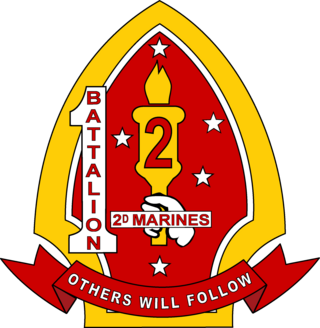
1st Battalion, 2nd Marines (1/2) is an infantry battalion in the United States Marine Corps based out of Marine Corps Base Camp Lejeune, North Carolina, consisting of approximately 900 Marines and sailors. The battalion, callsign "Typhoon'" falls under the command of the 2nd Marine Regiment and the 2nd Marine Division.
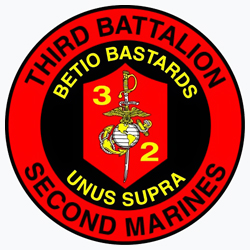
3rd Battalion, 2nd Marines (3/2) is an infantry battalion in the United States Marine Corps based in Marine Corps Base Camp Lejeune, North Carolina. Comprising approximately 1000 marines and sailors and nicknamed the "Betio Bastards", they fall under the command of the 2nd Marine Regiment of the 2nd Marine Division.

2nd Battalion, 2nd Marines (2/2) is a light infantry battalion in the United States Marine Corps based out of Marine Corps Base Camp Lejeune, North Carolina. Also known as "The Warlords", it consists of approximately 1,300 Marines and sailors and normally falls under the command of the 2nd Marine Regiment and the 2nd Marine Division.

The 2nd Marine Regiment is an infantry regiment of the United States Marine Corps. They are based at Marine Corps Base Camp Lejeune, North Carolina and fall under the command of the 2nd Marine Division and the II Marine Expeditionary Force.

The 1st Battalion, 6th Marines (1/6) is an infantry battalion in the United States Marine Corps based in Camp Lejeune, North Carolina. It consists of approximately 1,100 marines and sailors. They fall under the command of the 6th Marine Regiment, the 2nd Marine Division of the II Marine Expeditionary Force.

2nd Assault Amphibian Battalion is a mechanized battalion of the United States Marine Corps. Their primary weapon system is the Amphibious Assault Vehicle. The battalion is a separate battalion within the 2nd Marine Division and the II Marine Expeditionary Force. The unit is based out of the Camp Lejeune, North Carolina

The 2nd Reconnaissance Battalion is a reconnaissance battalion in the United States Marine Corps. Located at Marine Corps Base Camp Lejeune, North Carolina, the battalion falls under the command of the 2nd Marine Division and the II Marine Expeditionary Force.

The 15th Marine Expeditionary Unit is one of seven such units currently in existence in the United States Marine Corps. The Marine Expeditionary Unit (MEU) is a Marine Air Ground Task Force (MAGTF) with a strength of about 2,200 personnel. The MEU consists of a command element, a reinforced infantry battalion, a composite helicopter squadron and a combat logistics battalion. The 15th MEU is currently based out of Marine Corps Base Camp Pendleton, California.

The 4th Reconnaissance Battalion is a reserve reconnaissance battalion in the United States Marine Corps. It falls under the 4th Marine Division and Marine Forces Reserve.

Combat Logistics Battalion 15 (CLB-15) is a military logistics battalion in the United States Marine Corps based out of Camp Pendleton, California. It consists of approximately 275 Marines and Sailors. It is part of Combat Logistics Regiment 17 within the 1st Marine Logistics Group, I Marine Expeditionary Force. When assigned under the operational control of the 15th Marine Expeditionary Unit, it becomes the Logistics Combat Element (LCE) providing expeditionary combat logistics support to all supported elements of the Marine Expeditionary Unit. CLB-15 has two sister MEU CLBs also based out of Camp Pendleton: CLB-11 and CLB-13.
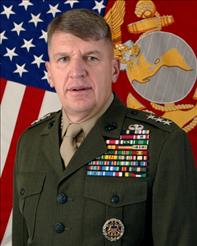
Richard F. Natonski is a retired United States Marine Corps lieutenant general whose last assignment was as the Commander of U.S. Marine Corps Forces Command. He assumed the post in August 2008, having previously served as the United States Marine Corps Deputy Commandant for Plans, Policies and Operations from 2006. He retired at Marine Barracks 8th & I on 8 September 2010.
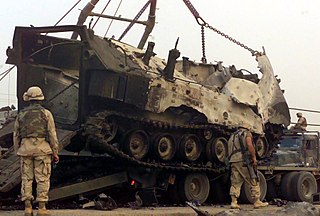
The Battle of Nasiriyah was fought between the US 2nd Marine Expeditionary Brigade, aided by the British military, and Iraqi forces from 23 March to 2 April 2003 during the US-led invasion of Iraq. On the night of 24–25 March, the bulk of the Marines of Regimental Combat Team 1 passed through the city over the bridges and attacked north towards Baghdad. However fighting continued in the city until 1 April when Iraqi resistance in the city was defeated.

The 2nd Marine Expeditionary Brigade is a brigade of the United States Marine Corps. It is part of II Marine Expeditionary Force. It advertises itself as a "middleweight" crises response force of choice in the European and Southern Command Areas of Operation. It is able to "operate independently, as a service component, or to lead a Joint Task Force". Self-sufficient and interoperable, the 2nd Marine Expeditionary Brigade possesses a mix of command and control, combat power and specialized logistics. Operating as part of the greater Marine Corps team and with support from the United States Navy and other services, it can provide operational reach.
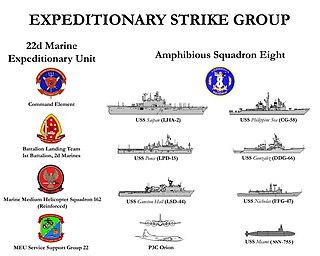
In the United States Navy, the expeditionary strike group (ESG) is a coordinated group of surface ships, aircraft, submarines, and other naval assets. In contrast to carrier strike groups (CSGs), which emphasize air power and are led by a supercarrier, ESGs are strongly suited for amphibious warfare and are led by an amphibious assault ship. The ESG concept was introduced in the early 1990s, based on the Naval Expeditionary Task Force. The U.S. Navy fields nine expeditionary strike groups.
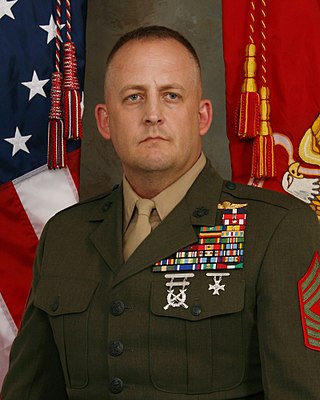
Justin D. LeHew is a United States Marine who served in the War on Terror. He was awarded the Navy Cross for his actions on 23 and 24 March 2003 during the initial 2003 invasion of Iraq. He was hand picked to spearhead the rescue operation and recovery of the U.S. Army's 507th Maintenance Company on 23 March and subsequently was called upon again to take part in the rescue operation of US Army Private Jessica Lynch on 1 April 2003. He is also a recipient of the Bronze Star with Combat Distinguishing Device denoting Valor for his heroic actions from 5 to 28 August 2004 during the Battle of Najaf.

Luis E. Fonseca, Jr. is a United States Navy hospital corpsman who was awarded the Navy Cross for extraordinary heroism on March 23, 2003, while assigned to a Marine Corps amphibious assault vehicle platoon serving with the 1st Battalion, 2nd Marine Regiment, during the Battle of An Nasiriyah in An Nasiriyah, Iraq. This was the first major battle fought in Iraq by the U.S Marine Corps during Operation Iraqi Freedom.

Expeditionary Strike Group SEVEN/Task Force 76 is a United States Navy task force. It is part of the United States Seventh Fleet and the USN's only permanently forward-deployed expeditionary strike group. It is based at the White Beach Naval Facility at the end of the Katsuren Peninsula in Uruma City, Okinawa, Japan.

Operation Noble Obelisk was the U.S. evacuation of civilians from Sierra Leone in 1997 by the American naval ship USS Kearsarge (LHD-3) and the 22nd Marine Expeditionary Unit.




















